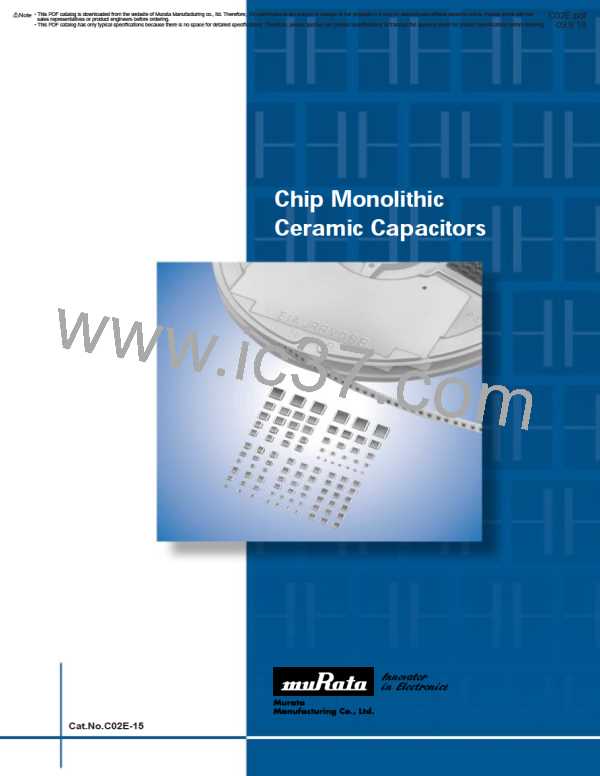• This PDF catalog is downloaded from the website of Murata Manufacturing co., ltd. Therefore, it’s specifications are subject to change or our products in it may be discontinued without advance notice. Please check with our
• Please read rating and !CAUTION (for storage, operating, rating, soldering, mounting and handling) in this catalog to prevent smoking and/or burning, etc.
!Note
!Note
C02E.pdf
sales representatives or product engineers before ordering.
• This catalog has only typical specifications because there is no space for detailed specifications. Therefore, please approve our product specifications or transact the approval sheet for product specifications before ordering0. 9.9.18
• This PDF catalog has only typical specifications because there is no space for detailed specifications. Therefore, please approve our product specifications or transact the approval sheet for product specifications before ordering.
Specifications and Test Methods
Continued from the preceding page.
Specifications
No.
Item
Test Method
No cracking or marking defects should occur.
Solder the capacitor to the testing jig (glass epoxy board) shown
in Fig. 2.
Then apply a force in the direction shown in Fig. 3.
The soldering should be done using the reflow method and
should be conducted with care so that the soldering is uniform
and free of defects such as heat shock.
b
φ4.5
d
c
a
50
Pressurizing
speed : 1.0mm/s
20
t : 1.6
100
12 Deflection
Pressurize
Dimension (mm)
LZW
R230
(mm)
a
b
c
d
4.5Z2.0
4.5Z3.2
5.7Z5.0
3.5
3.5
4.5
7.0
7.0
8.0
2.4
3.7
5.6
Flexure=1
1.0
Capacitance meter
45 45
(in mm)
Fig. 2
Fig. 3
Immerse the capacitor in a solution of ethanol (JIS-K-8101) and
rosin (JIS-K-5902) (25% rosin in weight proportion).
Immerse in solder solution for 2T0.5 sec.
Solderability of
Termination
13
75% of the terminations are to be soldered evenly and continuously.
Immersing speed: 25T2.5mm/s
Temp. of solder: 245T5°C Lead Free Solder (Sn-3.0Ag-0.5Cu)
235T5°C H60A or H63A Eutectic Solder
Preheat the capacitor as table.
Appearance
No marking defects
Immerse the capacitor in solder solution at 260T5D for 10T1
sec. Let sit at room condition* for 24T2 hrs., then measure.
#Immersing speed: 25T2.5mm/s
Capacitance
Change
Within T10%
D.F.
I.R.
0.025 max.
#Pretreatment
Perform a heat treatment at 150
let sit for 24T2 hrs. at room condition*.
W00
Y10
D for 60T5 min. and then
Resistance
More than 1,000MΩ
14 to Soldering
Heat
*Preheating
Dielectric
Strength
In accordance with item No.4
Step
1
2
Temperature
100 to 120D
170 to 200D
Time
1 min.
1 min.
Fix the capacitor to the supporting jig (glass epoxy board) shown
in Fig. 4.
Perform the 5 cycles according to the 4 heat treatments listed in
the following table.
Appearance
No marking defects
Capacitance
Change
Within T15%
D.F.
I.R.
0.05 max.
Let sit for 24T2 hrs. at room condition*, then measure.
12
Time (min.)
30T3
Temperature (D)
Min. Operating Temp.T3
Room Temp.
Step
More than 3,000MΩ
1
2
3
4
2 to 3
Max. Operating Temp.T2
Room Temp.
30T3
2 to 3
Temperature
15
#Pretreatment
Perform a heat treatment at 150
Cycle
W00
Y10
D for 60T5 min. and then
let sit for 24T2 hrs. at room condition*.
Dielectric
Strength
In accordance with item No.4
Solder resist
Cu
Glass Epoxy Board
Fig. 4
Appearance
No marking defects
Let the capacitor sit at 40T2D and relative humidity of 90 to 95%
W24
Capacitance
Change
for 500
hrs.
Within T15%
Y00
Remove and let sit for 24T2 hrs. at room condition*, then
Humidity
16 (Steady
State)
measure.
#Pretreatment
Perform a heat treatment at 150
D.F.
I.R.
0.05 max.
More than 1,000MΩ
W00
Y10
D for 60T5 min. and then
Dielectric
Strength
let sit for 24T2 hrs. at room condition*.
In accordance with item No.4
* "Room condition" Temperature: 15 to 35D, Relative humidity: 45 to 75%, Atmospheric pressure: 86 to 106kPa
Continued on the following page.
181

 MURATA [ muRata ]
MURATA [ muRata ]